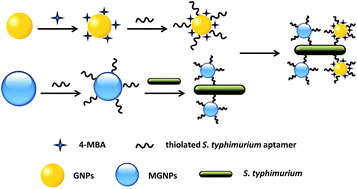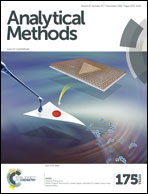SERS aptasensor detection of Salmonella typhimurium using a magnetic gold nanoparticle and gold nanoparticle based sandwich structure†
Abstract
A detection method for Salmonella typhimurium (S. typhimurium) using a surface-enhanced Raman scattering (SERS)-based sandwich structure was investigated. The biosensor was built on the basis of nanoparticle enhanced Raman intensity and the specific recognition of aptamers. Aptamer-functionalized magnetic gold nanoparticles (MGNPs) were used as the capture probe, while the aptamer and mercaptobenzoic acid (4-MBA) functionalized gold nanoparticles (GNPs) were used as the Raman signal probe. When S. typhimurium is added in the reaction system, the capture probe will capture the target bacteria through the specific binding effect of the aptamer. And then the signal probe will be connected to the bacteria also by the effect of the aptamer to form a sandwich-like detection structure. 4-MBA exhibits a specific peak at 1582.71 cm−1. Under the optimal conditions, the SERS intensity exhibits a good linear relationship (y = 548.3039 + 783.9842x, R2 = 0.9968) with the concentration of S. typhimurium ranging from 10 cfu mL−1 to 107 cfu mL−1. The LOD is 5 cfu mL−1. This method is simple and rapid, results in high sensitivity and specificity, and can be used to detect actual samples.


 Please wait while we load your content...
Please wait while we load your content...